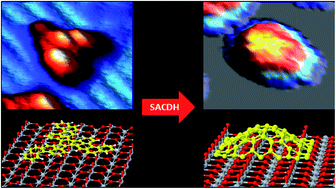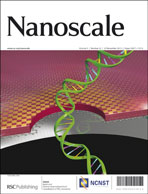Chemistry and temperature-assisted dehydrogenation of C60H30 molecules on TiO2(110) surfaces†
Abstract
The thermal induced on-surface chemistry of large polycyclic aromatic hydrocarbons (PAHs) deposited on dielectric substrates is very rich and complex. We evidence temperature-assisted (cyclo)dehydrogenation reactions for C60H30 molecules and the subsequent bottom-up formation of assembled nanostructures, such as nanodomes, on the TiO2(110) surface. To this aim we have deposited, under ultra-high vacuum, a submonolayer coverage of C60H30 and studied, by a combination of experimental techniques (STM, XPS and NEXAFS) and theoretical methods, the different chemical on-surface interaction stages induced by the increasing temperature. We show that room temperature adsorbed molecules exhibit a weak interaction and freely diffuse on the surface, as previously reported for other aromatics. Nevertheless, a slight annealing induces a transition from this (meta)stable configuration into chemisorbed molecules. This adsorbate–surface interaction deforms the C60H30 molecular structure and quenches surface diffusion. Higher annealing temperatures lead to partial dehydrogenation, in which the molecule loses some of the hydrogen atoms and LUMO levels spread in the gap inducing a net total energy gain. Further annealing, up to around 750 K, leads to complete dehydrogenation. At these temperatures the fully dehydrogenated molecules link between them in a bottom-up coupling, forming nanodomes or fullerene-like monodisperse species readily on the dielectric surface. This work opens the door to the use of on-surface chemistry to generate new bottom-up tailored structures directly on high-K dielectric surfaces.


 Please wait while we load your content...
Please wait while we load your content...